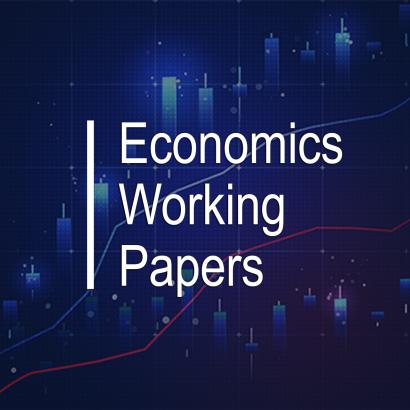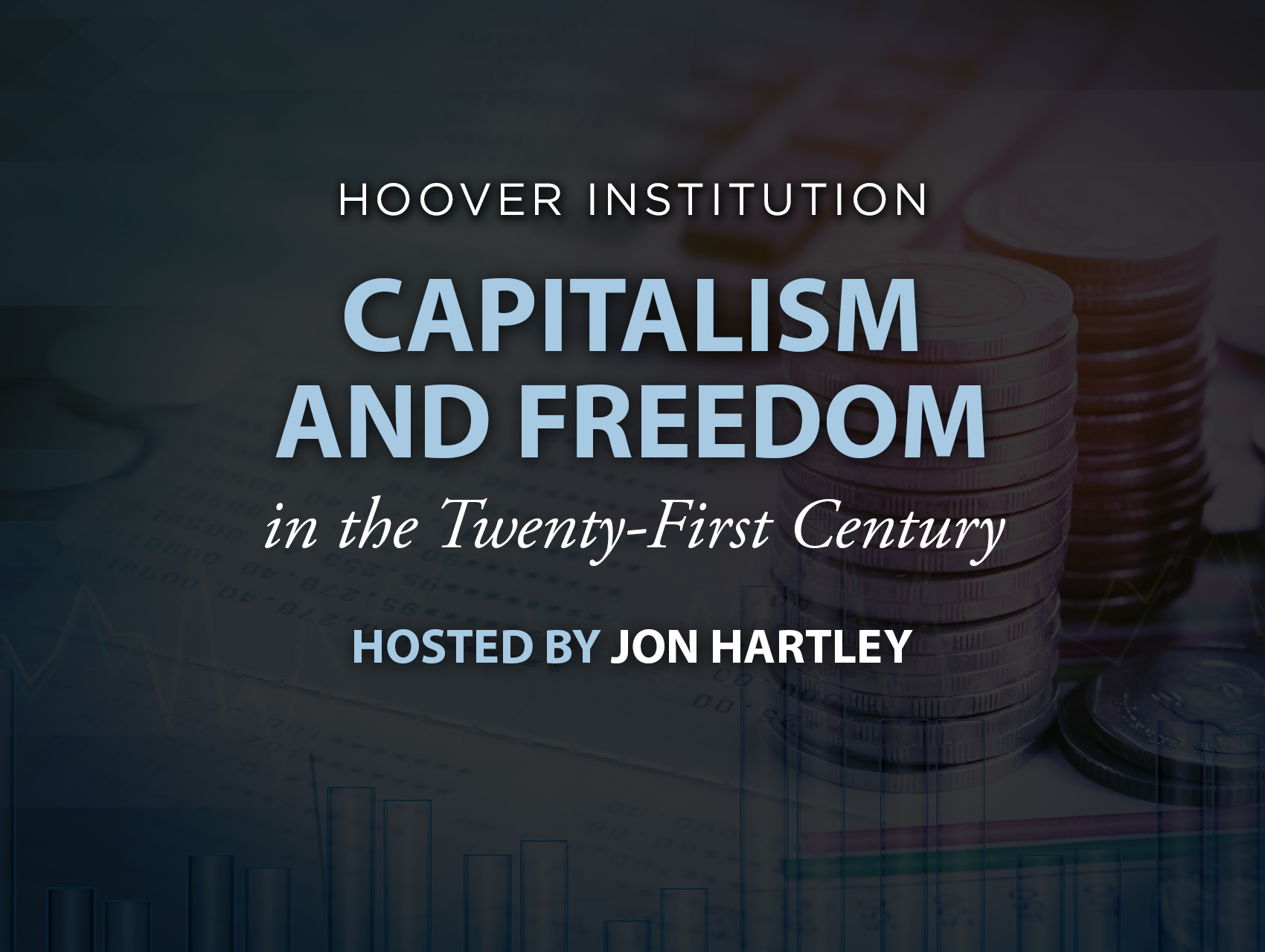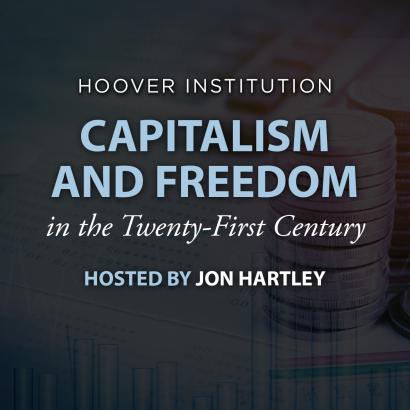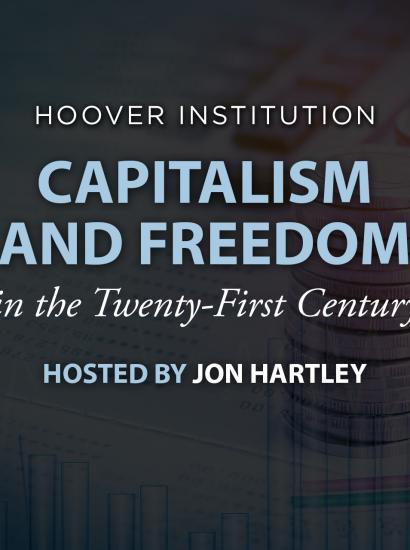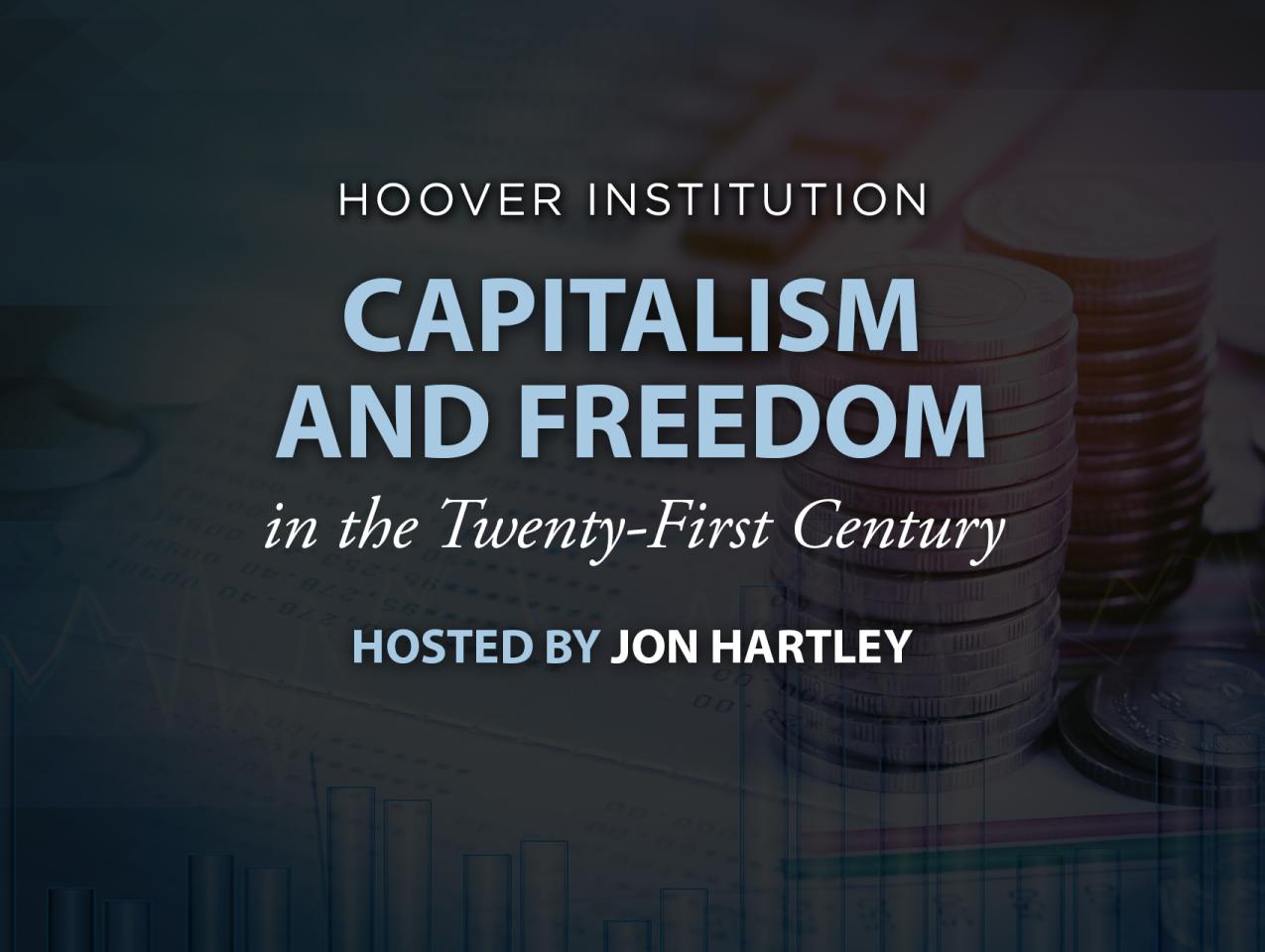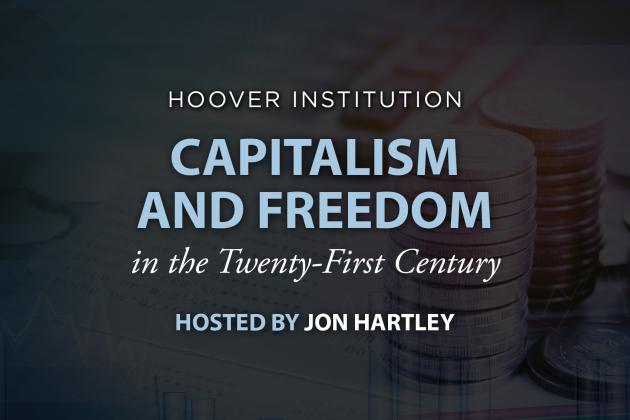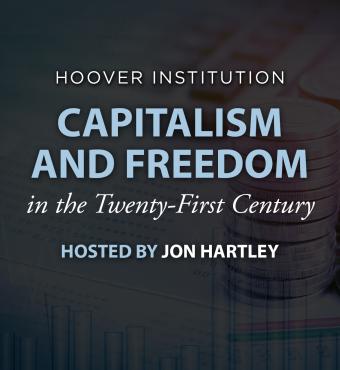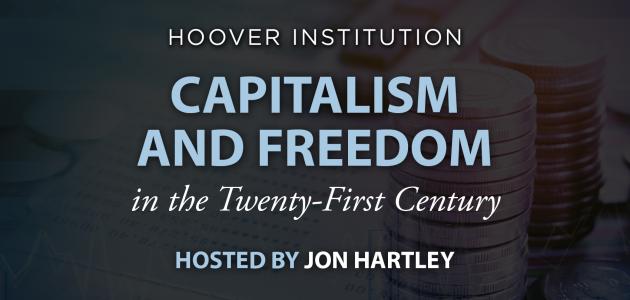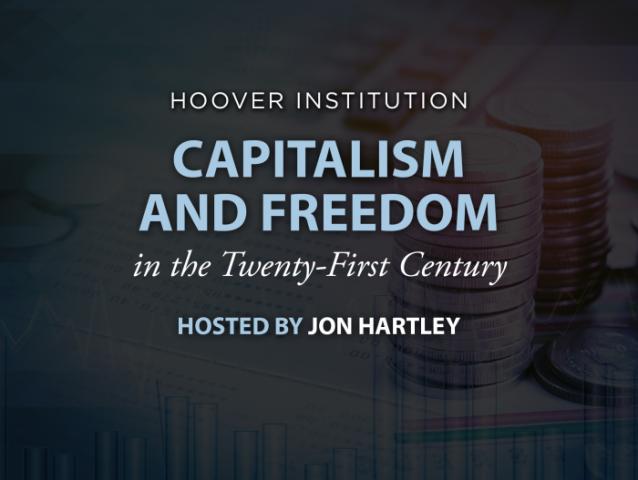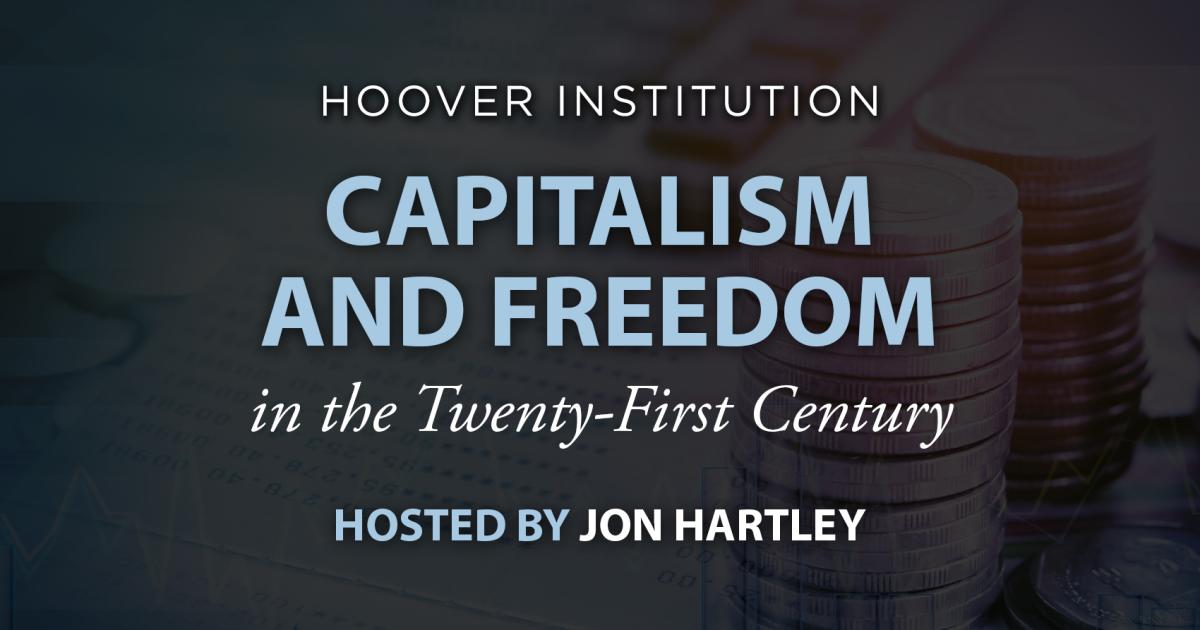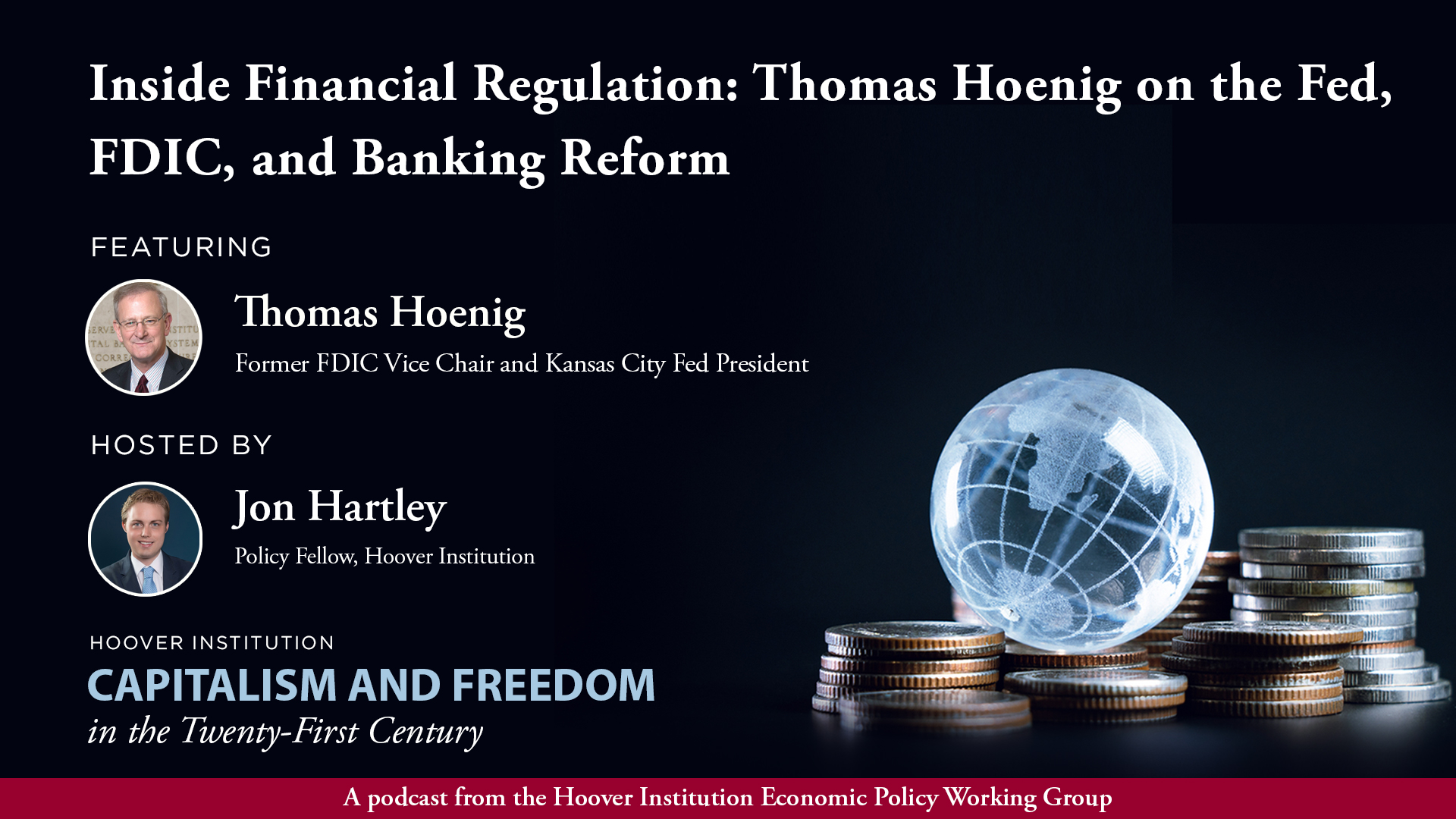- Regulation & Property Rights
- Finance & Banking
- Answering Challenges to Advanced Economies
Jon Hartley and Thomas Hoenig discuss Tom’s career as an economist, as Vice Chair of the FDIC, President of the Kansas City Fed, topics including the global financial crisis, banking regulation, Glass-Steagall, Too Big To Fail, moral hazard, lender of last resort powers, Basel III, the Dodd-Frank Act, capital requirements, deposit insurance after the Silicon Valley Bank regional banking crisis, and quantitative easing.
Recorded on June 10, 2025.
WATCH THE EPISODE
>> Jon Hartley: This is the Capitalism and Freedom in the 21st Century podcast, an official podcast of the Hoover Institution Economic Policy Working Group, where we talk about economics, markets, and public policy. I'm Jon Hartley, your host today. My guest is Thomas Hoenig, who is a PhD economist, a Distinguished Senior Fellow at the Mercatus Center, and the former Vice Chair of the FDIC during 2010.
And the President of the Kansas City Fed for about 20 years from 1991 to 2011. Welcome, Tom. So great to have you here.
>> Thomas Hoenig: Well, thank you. It's good to be with you, and I look forward to our conversation.
>> Jon Hartley: Start by gaining your early life. You were born in Iowa.
You did your undergrad at Benedictine in Kansas. You did your PhD at Iowa State. There's a close connection between Iowa State and Chicago that I think some people might not be aware of. Theodore Schultz and De Gal Johnson, agricultural economists who are both at Iowa State and went to Chicago, won the Nobel Prize.
I'm just curious, how did you first get into economics and financial regulation growing up in the Midwest?
>> Thomas Hoenig: Well, first of all, my dad had a small business, so I had trips to the bank with him. I knew that they were around, put it that way. But actually, I got most interested when I was in college.
I took a course, an elective course in economics in my freshman year, and just thoroughly enjoyed it. It was microeconomics, but it was very, I thought, useful and challenging. And so I decided that was what I was going to do. Although I did morph into money and banking as I graduated and then got into graduate school.
So I spent a lot of time in economics thinking about economics. And when I left the when I graduated out of my graduate program, I went to the Federal Reserve bank of Kansas City. And I had my specialty was money and banking. And so when I went to the Kansas City Fed, they had during the period where there were a lot of mergers among banks going on.
And so I went into the banking supervision and structure division of that bank rather than the monetary research division. And in that I learned a great deal because wasn't too long after I joined that we had the asset boom of the 70s and then the Paul Volcker era.
And I was in supervision and literally watched with disappointment, I guess I'll use that term in the hundreds of bank failures that were going on just in our region and across the country. And that got me interested then even more in what the causes were monetary policy factors in that, trying to deal with inflation.
And so I was pretty well prepared when they asked me to step into the role of president of the bank and join the FOMC, the Federal Open Market Committee, and its policy role. And so I had both kind of banking knowledge and the monetary knowledge. And I found it very, that combination very helpful to me in my career.
>> Jon Hartley: Well, it's terrific. You were there during the gold financial crisis. You were the president of Kansas City Fed when that happened, when those events transpired. And I feel like the financial crisis was both a defining moment for financial regulation and for monetary policy. It was really then when quantitative easing was starting.
I'm curious what went wrong in the financial crisis as you sort of see it in terms of underlying causes. What went wrong with the banks in your mind? Housing central to that was government subsidies important. There was lack of say bank capital an issue. Was complexity of the financial system an issue?
I'm curious. You gave a speech in 2009, you gave a speech titled Too Big Has Failed which was pretty critical I think of the approach taken until that time. How do you define the events of the financial crisis and its causes?
>> Thomas Hoenig: Well, I will tell you, first of all, I think most financial crisis post World War II, let's leave it.
And I'll also kind of mark out Covid but most financial crisis are actually policy related, usually excessive monetary policy. And that's one thing I learned as I dealt with banks and doing the crisis and that. And for example in the 70s what happened was the Fed not wanting to have a slowdown in the economy, repeatedly lowered rates.
And then as inflation picked up, they lowered them again, but they never really got an equilibrium. And over that time inflation, as you well know, went from modest 2.5% to 14% by the 1979 period. And what happened in that baits the banks, in other words, low interest rates, asset prices.
They began to land more on collateral value and the expectation that the value would only increase because of inflation and they're willing to make higher loan to value loans, take on more risk. And so then when you raise interest rate and those values plummeted, these banks were ill prepared to deal with it and they didn't have enough capital given the size of the adjustment that had to take place.
So that happened in the 80s, 70s, and 80s, and then we actually repeated it after the, in beginning of the decade of 2000, where I was a member of the FOMC then I, did object, but not enough. And we saw interest rates decline to as low as 1% even when the economy was growing in 2003.
And what that did is it brought forward the speculative elements in the economy because of very low interest rates. You could borrow a lot of money at, say, 2%, buy a company, finance it with debt, strip out the equity, take the cash, move on, but creating increasing amounts of instability until finally inflation took off.
They raised rates. And we had an enormous financial crisis around housing because people have been taking equity out of their homes and spending it. More leverage, more downside risk. And when it finally hit, we had a major problem again. Following Covid, the Federal Reserve, extended its loose monetary policy, accommodated monetary policy well past the COVID crisis.
It held onto that $120 billion a month injection of new reserves into the system for over 18 months. And we had a breakout of inflation. It exceeded 9% at one point. And then they had to raise interest rates. And, of course, asset values in the banks plummeted. We had the Silicon Valley bank failure and then a bank run on many banks, and that because no one knew for sure how they were affected.
So those are the sorts of things you have to think about in monetary policy. What is your policy gonna do to the institutions when you adjust it? And I think that was lost in each of those occasions, and why we had a worse crisis as a result. When I talk about too big to fail, the other side of that was some banks were, shall we say, protected, while other banks were not.
And it created an instability and uncertainty in the system that I think was very harmful to the economy. You know, prior to the great financial recession, when Solomon failed, it failed. We didn't bail it out, and we didn't bail out the banks lending to it. But when we got to the great financial crisis and banks were under pressure, especially the large banks, Citibank, you name it, the, the Fed said, no, no, we can't have that.
So they actually provided enough enormous amounts of liquidity into the system that the treasury helped provide capital, something they wouldn't do for a regional bank or smaller bank. And so we, we set up an expectation that the largest banks would be bailed out at whatever cost. And that discriminated against all the other banks and made our bank and our economic system less efficient.
And so I had real objections to that as well, John, and still do to this day.
>> Jon Hartley: Well, I guess there's this famous question about should Paulson and Bernanke have saved Lehman? And I guess there's this question of what does a run on, I guess the shadow banking system look like?
And this is a traditional run where I guess you have depositors lined up at a commercial bank trying to get deposits out, but really you have investors, money market funds getting tons of redemptions, people are worried that there's exposure to Lehman commercial paper and that that triggers this, all these redemptions which sort of forces further selling and so forth.
I guess the argument, I mean, it seems like, during that period, I mean, there were a series of these distressed firms, whether it's Bear Stearns eventually getting bought up by JPMorgan or Merrill Lynch getting bought up by Bank of America and so forth. You have some assistance from the Fed in some of these cases, but there are some people that argued that Bernanke and Paulson should have acted more to save Lehman.
And there was a deal lined up with Barclays, I think, to buy Lehman, but I think the UK prevent it from happening. It's kind of the Paulson story that he tells, that that was, I guess, a central challenge. But other I think Randy Quarles, for example, might say countrywide was kind of, I guess the moment that things were getting really bad.
I'm curious what your sort of diagnoses are of, of that period of time and all these bailouts and, and what should have been done differently, if anything.
>> Thomas Hoenig: Well, my complaint was to begin with, when they decided for whatever reason to bail out Bear Stearns. It was not the largest institution in the world, but they were afraid of contagion effects or whatever the reason was.
I thought that set the expectation. And when you, once you set the expectation, then you live with it. And the expectation was, anything that large or larger is going to be bailed out. It even set the expectations for Lehman itself. Had they let that fail, it would have required, it would have caused, I should say, a whole different, I think, set of responses in the banking industry and in the investment banking industry.
And it would have said, wait, I better be thinking about how much capital I have. I better be thinking about the distribution of my assets on my balance sheet and the quality of my assets and whether I should build liquidity. This was in March of 2008, and then you had, basically, the GSEs.
And you put them into conservatorship, but in fact you bailed out the creditors. Not that, not the investors, but the creditors big time. And so you set the expectation. So then when you give them the Lehman Brothers, you've set the expectations. To change direction at that time is to invite a crisis is to.
Because now you're saying, wait a minute, those were the expectations, but they, but they're not living up to them. I better run and I better not take any chances because I don't know how other banks like Citi or so forth, how they prepared for it, because we know Lehman's didn't prepare for a further liquidity squeeze at all.
And therefore you created this monster. So the mistake was starting out by bailing out. Once you start down a path, you can't change during that crisis. And they tried to do that, which was a serious error at that point.
>> Jon Hartley: I'm curious how you think of, I guess, some of these arguments around Glass-Steagall and Gramm-Leach-Bliley and Glass-Steagall.
And a large part that people talk a lot about is separating commercial banking from investment banking. And Glass-Steagall and Gramm-Leach-Bliley and other legislation around that time in the 90s, Glass-Steagall's something passed in the 1930s. Gramm-Leach-Bliley, in the sorta deregulatory period in the 90s, allowed for a lot of consolidation in the part of the banking system.
Some people will say, like Elizabeth Warren will say, Warren will say breaking up the big banks would be a good thing at some level. I think it would make the financial system less stable in the sense that these larger banks that we now have as a result of this consolidation sort of benefit from being more diversified.
They have both commercial banks and investment banks under one umbrella. And if you look at the performance of the larger banks, the JPMorgans, the Citis, the banks, Bank of America and Wells Fargo, I mean, they were generally safe during the financial crisis. And it was, generally speaking, those that didn't have diversified businesses combined that were struggling.
This is an argument I've heard from Bernanke and others or others have mentioned before. I'm curious what your thoughts are I guess on consolidation. I mean, now we're also seeing a non-banking sector sort of emerge that's growing a lot, non-bank lending, think the Rocket Mortgages of the world.
I'm curious how you see sort of I guess the financial system evolving and how consolidations played a role in that.
>> Thomas Hoenig: Well, let me go back to the first part and that is, you know, Ramleach Bliley, I oppose that at the time and, and the reason was though not that I necessarily anything against mergers but the fact was the commercial banking industry was the only one that was heavily subsidized in the sense of deposit insurance.
And we knew from other experiences, continental Illinois that they would likely be bailed out if there's a private. And so now you're taking this commercial banking and you're saying, we're gonna allow commercial banks and investment banks to merge. Well that sounds great except you're also then indirectly and sometimes very directly extending the safety net from just the commercial banking industry to the investment banking industry, especially when it's under the umbrella of a single bank holding company that owns both because as a policymaker that if either one of them get in trouble, both of them get in trouble because people, they don't distinguish, they can't be sure how much overlap is there.
And I gave a speech in 1999 as this thing was being passed, saying, you will now have systemic risk For sure, you've invited systemic risk into the financial system and that actually entrenches to be to fail because now everything is implicitly insured. And that's exactly what happened. They say, well, J.P. morgan, the others were satisfactory capitalizing the great financial crisis.
That's not actually true Because the US government through TARP, put up in place a $600 billion bailout for the industry. And Citibank, which was clearly on the ropes to failure, had equity injected preferred stock. They gave him enough capital and then if you look at the data, the Federal Reserve made enormous loans to these institutions during that period.
They, they were, they were provided all the liquidity they need. And that was so called QE1, but it primarily was a liquidity vehicle. I did not object to that because they did have, most of them did have good assets. And when the treasury was done putting equity in them, they all had sufficient capital, but they were bailed out in every sense of the word.
And they had to be because now you had merged banking and investment banking together, these, they were much larger at the time of the 2008 crisis than they were in 1999 or 2000 when Grammarly Spotty was passed. So you invited this systemic effect and you got it and we have it today.
There's no way you could allow any of those institutions to fail today. And that's going to continue on into the future. And it gives them a huge competitive advantage. And it isn't, it actually is encouraging the consolidation for the consolidation of the industry. I recently was talking to a organization that merged and they said, Tom, we didn't have a choice.
For example, they said when Silicon Valley hit, we had, we were well capitalized, but we had a run on our bank. And they ran to the New York banks, to the too big to fail banks or into Treasuries. And so we had to over and over emphasize we were very well capitalized with very good assets, stay with us and they survived.
But they said we're not sure we can survive the next time that happens. So we've created our own future process of bailouts that are unavoidable and very much entrenched into our financial system today. Which brings me to the shadow banks or the private equity groups. If you think ahead and you, you think about private equity and so forth, they're large enough that I think the liquidity provisions of the Fed will flow through to them if any one of any significant size gets into trouble because they'll be afraid of a systemic fix.
And one of the Primary lenders to these private equity, besides how they raise money are commercial banks. So it fall back on them, so we broaden the range of trouble. Also, I think there's strong likelihood we'll pass this so called genius act, which is a law that would, shall we say, put a sanction through regulation on unstable coins.
That is basically money markets that have government securities as backup and they can also engage in payments. And when you do that, I think it's fine to have them if that's what they want and if that's what people want to invest. But once they become subject to government regulation and oversight and people then think they're protected when a crisis happens, the government will step in and bail them out.
And if you don't believe me, think about the money markets. In the great financial crisis. The money markets were supposedly backed by very safe assets, the most liquid assets. And yet one of the money markets broke the buck and they were all bailed out. So we're moving away from a market economy.
We're moving away from a government will bail out certain large institutions and certain kinds of institutions. And I think that makes it in the long run. In the short run, everyone wants to be bailed out. And if I had money in a bank that was there, I'd want my money.
However, in the long run we're weakening the system overall.
>> Jon Hartley: So I suppose in the aftermath, the golden finish, we adopted these Basel 3 capital standards for gibs globally systematically important banks. We've got sort of this regime of two types of capital ratios. We've got the, the risk neutral one, which is the supplementary leverage ratio.
We got the risk weighted one tier one common equity. And we've also got, you know, a regime of bank stress tests, you know, CCAR dfast, these things that the Federal Reserve does. And they sort of have these opaque scenarios that bank balance sheets are supposed to be able to withstand in these simulations.
And if they don't hold up to mustard, they can't issue dividends, they can't return to cash to shareholders. That's kind of the system that we've lived in. I think there's some good evidence that we're in a much safer place now than we were before. Now bank capital ratios are much higher.
I think bank CDS spreads have generally been lower and bank volatility has been lower. And if you look too just in the recent crises periods at some level I think banks held up pretty well during, during COVID and then even during the regional banking crisis. I think it was largely one bank, Silicon Valley bank, that had some serious problems in terms of managing the duration of their balance sheet.
And then you also had that combined with the uninsured deposits issue, having lots of uninsured deposits. I think that was a one off kind of issue. Sure, there were Signature bank and some credit crypto and Credit Suisse was sort of teetering for quite a while but I think by and large I think things are safer and better now.
I mean, tell me, is that right or wrong in your mind?
>> Thomas Hoenig: Well, it's relative. I don't agree with you totally, but it is relatively safer. But here's what I would tell you. First of all, the banks are not that well capitalized. They are when you look at the risk weighted capital and you look the amount of risk weighted assets to total assets is about 50%.
So that process weights mortgages at 50% of their book value. It weights other assets at 20 to 30%. And it weights government Treasuries at almost nothing. And so you have these very high 13 rates. But when you look at the leverage ratio, how much capital do I have relative to my total assets available to absorb loss?
That's the leverage ratio and it's 7%, 7 cents on a dollar. And in the great financial crisis we lost. The banks lost even the largest, about 6 cents. So you know, there's not that much capital. When you say gold plated, I think that's a word that's been used to convince people to believe them because it isn't true.
They're capitalized better because at the great financial crisis because of the risk weighted system they were about 4%. But there was a time when you had capital ratios of 10 and 11%. And for regional banks they are, they are capitalized leverage ratio of 10%. So it's, it's a relative thing.
It's better, but it's not, they're not well capitalized. And I would tell you, we talked about Silicon Valley and the banks got through it in the economy, but the Fed preemptively pumped hundreds of billions of dollars into the system to provide it the liquidity, the access to, to, to enable companies, municipal com, municipalities to stay solvent, not have a liquidity breakdown.
It did preemptively because you had to run on the banks when Silicon Valley failed. Because when you looked at the balance sheets of the banks at that time, there was about $600 billion of unrealized losses on those in those balance sheets that were not recorded because of the accounting rules allowing you to not have to charge those off.
So were we really, could we really absorb $600 billion of losses? Well, the idea is, well, they'll basically, you let them amortize until interest rates come back up. Well interest rates were zero for about 15 years. So then they shot up and you had the shock and you have the effects of that.
There wasn't enough capital to absorb that without the Fed. So now the other thing that's happened, John, is that the banks, the Federal Reserve's balance sheet, which was once less than a trillion dollars, grew to $9 trillion. But here's the important point. Its footprint in the market, in the government securities market has become enormous.
It calls the shots. And so you don't really have a market there. You have the Fed and one of the, you know, they, they say that the dual mandate for the Federal Reserve is maximum employment. Right. And.
>> Jon Hartley: Price stability.
>> Thomas Hoenig: Well, I was going to say interest rates or something, price stability but they define the Fed defines it as low inflation, not price stability.
And I like to make that distinction there. But here's the main point. They have an unstated absolute mandate. Keep the, keep the securities, federal securities market stable and able to issue debt. That's, that's their mission and that is a primary mission, their operating procedures are around that. They have a standing repo facility that's around that goal.
There didn't used to be that you had the discount window if you need a temporary liquidity and you have the assets to declare, but now just call them up, it's yours. So we've become, the Fed's become a much more important player in the securities market generally. And the bond vigilantes will only come into play if the Fed sticks to its guns on its quantitative tightening, which it is just about done with, I think, and then we'll see what happens from there.
>> Jon Hartley: So I guess to speak clearly, so you're diagnosing the banks as not being as safe enough potentially to withstand another global financial crisis today. And, and I guess would your policy prescription be we need even tighter capital ratios for, for the banks. Would that be your.
>> Thomas Hoenig: Well, my, here's here, I've said this for years.
The banking industry, the largest banks included, the banking industry is over regulated. I mean that's why you have the shadow banks and everything else going on. It's over regulated. And my view was keep the capital high and the rules minimum and simple. Because when the industry was not, didn't have the safety net of the Fed and didn't have the safety net of the FDIC and didn't have the safety net of the government putting equity in capital ratios were 20 and 30%.
Now I'm not advocating for that, but I am advocating for 10 to 15% then and I would get rid of, I mean, stress tests. Come on, I mean they haven't failed a stress test in 10 years. That's process, expensive process. The risk weighted capital measure which the banks favor and the government favors is costs hundreds of millions of dollars, billions of dollars wasted when a simple leverage ratio does the same thing in a much more effective way because it tells you transparently how much can this bank lose before it's insolvent.
It puts discipline out there. So I would have the capital ratios high, give people confidence and get those rules minimized. And I think you would see more business come into the banking industry than leaving. And you'd have a, you still have a, you can always have a crisis.
But right now the largest banks under the risk weighted system are homogenized and into a single bank there's no differences because the risk weights on the assets define where you put your money.
>> Jon Hartley: Right? Well, I guess, wouldn't that be a criticism of the simple leverage ratio, supplementary leverage ratio too in the sense that.
Well, you could do to respond to that is just by you could still keep the same overall level of risk for your equity by just investing the assets in much riskier securities or investments. Think buying 3X levered ETFs or whatever have you to compensate for that.
>> Thomas Hoenig: Yes, I know the argument.
But here's what I tell people. If you didn't have too big to fail and capital was as it's supposed to be. So I want to have a bank, I gather capital now I have to, I'm the management. I'm not the government. I'm the management. And I have to decide how much do I have in riskier loan assets for return.
How much do I have in governments to get a return but provide some liquidity. How much do I have in consumer. Okay, so I know there's risk there, but there's a good return. I have to make those decisions and I have to make them for the long run benefit of my stockholders and my survivability.
But now I know I'm too big to fail. Or creditors know that banks are going to be, they're going to get bailed out even though they invested my lose. So they don't mind putting money into high risk organization because they may get, they're, they're sure they're going to get their money back.
You've distorted the market process and, and, and you're proud of it. And I'm saying no, I'm not proud of it, the market gives us in the long run the most effective outcomes. Look at us today. The leverage, excuse me, the risk weighted capital measure is tilted to encourage banks to invest in government debt because you have a ton of government debt to issue.
Well, that's not a reason to have a risk weighted system. And now there's a proposal. The Secretary of the Treasury and each of the agencies have under consideration a proposal to exempt government securities from any capital standard. That's, that's saying, okay, no cost of capital, go ahead and invest in all the government that you, that you want because it's not going to cost you anything.
It's just gravy, isn't it?
>> Jon Hartley: Just for Treasuries, though, excluding.
>> Thomas Hoenig: Just for Treasuries. But, that's what I mean. So the government, so the government has a Treasury auction. I'm the bank I lend the government the money. I take the government's securities, the government takes the cash, it spins that money, it circulates back to the bank, so it has the Treasuries.
But now it's circulated back because the government spent. It goes back into the banking system, much of it, not all of it. And I buy another tranche of new government debt. As long as the government has to issue new debt, I'm there to do it and there's no cost to capital.
Well, now you've taken any discipline from the government away to print money. Even the Fed is out of the picture there. I mean, we're going down a road that I'm not sure you ever get back from without a major crisis.
>> Jon Hartley: Just speaking of, I guess, recent crises.
So we did have this Silicon Valley bank regional banking crisis, 2023. And I'm curious what you think about deposit insurance, because I think we're in an interesting place there. So, we had, again, you had a few banks, a lot of uninsured deposits, forgot how to manage interest rate risk.
FDIC came in, resolved the banks, but there's still this weird kind of thing which is well, we kind of have this implicit unlimited de facto deposit insurance now. And of course, before you had $250,000 for every bank account. And in theory you could go to every bank in the United States and that would give you hundreds of millions of dollars of deposit insurance.
I mean, I don't think in practice anyone's done that. Maybe, I don't know, but you could in principle. And now we sort of have unlimited de facto deposit insurance. I'm curious, do you think that's, I mean, there's lots of, I guess more hazard issues that some people raise.
Do you think that this is a problem where we're at with deposit insurance and what do you think things should be?
>> Thomas Hoenig: I think we're past that point. I mean, the moral hazard issue, if you take into account the too big to fail banks and you take into account the reasonably sized regional banks, you may let the investors in the regional banks fail, but you will not let the creditors.
We know that from Silicon valley. So, about 70% or more of deposits are directly or implicitly insured now. So we're only talking about a small percentage, which are primarily the community banks, as we learned that their depositors are not 100% insured, they're the only ones. So I think you have an argument for just 100% deposit insurance because the moral hazard issue off that is going to be that much larger and it's more fair because you've gone down that road and you say fair.
What's fair? Well, if you're going to have a banking industry under the same rules, you better have a banking industry under the same rules. Otherwise you bifurcated it and you've treated some differently and it actually accelerates the consolidation process as you go down the road. So I think it was a very bad mistake.
I also wonder to myself in the Silicon Valley situation I cannot understand as a former vice chair of the FDIC, to how you made, you couldn't have made the least cost test for bailing out depositors. It was a systemic crisis test only because a lot of depositors, very large, influential depositors, would have lost money, maybe 20% of their deposit in the end.
And so, you've changed the game. You once again changed the game, and I think that's unfortunate. So, yeah, we have the moral hazard problem, and adding another 20% or 30% to it isn't going to be that much more expensive, given where we are today. Now you have to worry about who's entering it.
But look what you have going on at the moment. You have a whole new system of stablecoin emerging. We have many, many issues ahead of us that will focus the debate about moral hazard going forward.
>> Jon Hartley: Well, I'm curious, so let's talk about monetary policy for a minute here, because this is, I think, a somewhat related topic coming out of the global financial crisis.
The Fed did its first sort of quantitative easing rounds where they were buying up a lot of these toxic assets and they were helping to resolve bank balance sheets. And so that was, I guess, the sort of initial foray, maybe QE1, I think, is what people call it.
But then if you've asked for it a couple years later, start getting this new process, starting with, I think, QE2, which is the Fed going out, buying treasury bonds and issuing reserves, paying interest on those reserves, and also buying not just treasury bonds, but mortgage bonds too, GSE backed mortgage bonds, buying those, expanding the size of the balance sheet.
And this goes on for quite a period of time. And then in more recent years, the Fed's tried to unwind some of this Quantitative tightening is what some people call it. And we've had some hiccups along the way. For example, the repo crisis of 2019. The banking system has sort of adapted to this new world.
And I'm curious, you've been a long time critic of quantitative easing. What are your criticisms of quantitative easing in this system? Well, first of all, QE1, which was in the crisis itself.
>> Thomas Hoenig: I voted for it, but it wasn't even called QE. It was a liquidity facility given the circumstances of the moment and the size of the freeze up in the market.
>> Jon Hartley: Okay, Judicial lender of last resort, lender.
>> Thomas Hoenig: Of last resort, liquidity provider of last resort. And the idea was that's kind of the theory of central banking for banks that are sound and I won't get into the ones that weren't sound and were bailed out. That we've already talked about but that was fine.
But what I found objectionable was QE2, 3 and 4 all the way through post Covid, because there was this view that unemployment was still high. But in the third quarter of 2009, even before QE2 started, the US economy was in recovery. Industrial production was picking up, employment was picking up.
But there was a view among some that, well, employment was still close to 10% too high and we might be able to bring it down faster if we do QE2. And I said, it doesn't work that way. I mean, bringing people back in takes time. We have a recovery underway.
Let's look at the recovery. Let's be patient because if we go down that road, I said, you won't be able to get out of it. I said in QE1, the whole idea was we're going to do it and then we'll pull back. And instead we're not pulling back, we're going forward with even more, hundreds of billions of dollars more.
And I said, what you're going to do is you're going to set a new equilibrium around zero interest rates and high reserve balances. And they say, well, we're not printing money. Yes, you are printing money, you're printing high powered money and you're keeping interest rates from going negative by having reverse repos.
So you're putting it in over here and you're pulling it over there. I said, why would you do that? Because it provides enormous liquidity into the market to take care of things. But what were the other effects? Because you had this cheap borrowing capacity. You went in and you encouraged speculation.
You encourage hedge funds to go in and buy companies, borrow the money to buy them, strip out the equity and then move them offshore. That's number one. Number two, they said, well yeah, but they'll take, the investors will take that money and they'll invest it in other things like the stock market.
Well, the only thing you did with the stock market, that's not new investment, that's not plant and equipment, that's raising the price to earnings ratio. And that's what they did. So how much more productive did we become? Well, that decade was a low productive decade and a low real increase in wages.
So you accomplish nothing but to distort the allocation of resources, find yourself unable to pull back without having a crisis. You know, the paper tantrum and all that stuff that followed and we're still suffering from it today. And we go, we go past the COVID period and we're bailing, we're, I understand we put the money in and I would have been for it from March of 2020 to August of 2020, but they continued quantitative easing for another 18 months.
And what they did is they increase asset value. So we had further just redistribution of wealth, relatively speaking, because if you held assets, you were richer, if you didn't, you didn't gain much. And, and what do you, what, what else did you sow? Societal unrest because people were saying, wait a minute, this isn't fair, I want mine, I want mine.
And so now we have a government spending $6 trillion a year, issuing new debt of $2 trillion because everyone wants theirs and it's not going to end well.
>> Jon Hartley: Well, I'm curious about like I've heard those same arguments from QE critics in the past. And I’m curious, what about this for a different argument that QE largely awash, in the sense that, sure, the Fed goes out, buys some 10-year longer-dated Treasuries, maybe they decrease the yields on those by 20 basis points, 30, 40 basis points, I've done event studies myself.
Other people have done event Studies that find some small but meaningful effects to that extent. They issue some reserves and just paint bearing reserves. At some level they're taking in treasuries and long term maturities, issuing essentially very short term maturities or reserves. And it's kind of just swapping one hand for the other.
I'm curious what you think about that at some level too. I think that there is some conflation in my mind. I don't buy the argument that quantitative easing is responsible for the run up in US equities in the past decade and a half or so. Because I think you look at the US compared to say Europe, Canada, Japan, a lot of these, Europe, UK, Japan, they've had just as much quantitative easing as a fraction of GDP.
And those places have had stock markets that are essentially flat for the past 15 years or so that haven't seen almost any return. Their GDP per capita has been extremely flat as well. I think the difference between the US and those places are largely the US has this massive tech sector that's very vibrant and we can debate why it has that, but it has it and these other countries and regions don't.
And if you were to strep out the earnings and the productivity from the tech companies in the US, you probably would see something. You see a US economy that looks pretty similar to Europe, UK, Japan and maybe Canada. I'm just curious what your thoughts are on that. That like the inequality thing might not necessarily be what's going on.
I buy the whole, once we're in this thing, it's very hard to get out. And if you were to get out of it, you'd need a Fed chair and an FOMC that is extremely laser focused on doing it. Even if it did upset investors, they'd have to communicate extremely transparently.
But yeah, the whole inequality thing, QE I've never really bought.
>> Thomas Hoenig: Well, first of all, we'll have to see how the, how, how it all plays out in the end. But number one, I would say, you know, frankly, Europe, Japan, Canada, they all did quantitative easing, you're right.
And a good part of that was strengthened the dollar as they invested in our tech. So the money did move, it moved in it. But the other part of it is okay, so you want to argue about it didn't, it didn't matter relative to equities, housing, other assets, both here and in Europe and Canada, inflation, they all have experienced that.
And that didn't happen because we reduce the amount of money in the economy, the nominal GDP numbers are all up nominal-wise, even though sometimes productivity isn't as high and so forth. So I mean your market signals have been distorted, the relative cost of capital has been distorted and the effects have been, I think for the most part damaging.
And if you didn't have the QE and you still had the technology, yes, they may not carry the values price to 200 to 1, price to earnings or price to book, whichever, but they would still be very successful companies. You didn't need the money printing the QE to make them successful.
That's not why they were successful. And therefore that doesn't excuse the fact that we've expanded the wealth difference in this country across the board, not just in stocks but in every asset held. I don't see any good outcome from that.
>> Jon Hartley: I guess on the inflation point, I've always associated the 2020s, early 2020s inflation more so with, I guess, the fiscal policy and transfers that hit all these people's bank accounts, whether it's the economic impact payments in the US or PPP loans and so forth.
I guess, looking at how the Fed performed during that period of time, do you think that the Fed made a critical mistake by not raising rates early enough when it was very apparent, say by October 2021, that the inflation story wasn’t purely about used car prices jumping, and that it was very broad-based and involved housing rents?
I'm curious what you think about how the Powell Fed has performed in recent years, how they responded not only to the great inflation, but also to COVID. I mean, how would you rate them in that sense?
>> Thomas Hoenig: Well, in terms of the response to Covid, they did more than they needed to do, but I wouldn't criticize them.
I mean, in a crisis like that, you do what you have to do. I'm not going to criticize them. I think after August, when we knew that recovery was underway, then it was clear that they should been they didn't have to, they didn't have to shock the economy.
They just, instead of 120 billion of new reserves a month, weaned the economy off that gradually. Rates didn't have to be zero after a while. I mean, they didn't have to be five and a quarter percent either, but they could have been higher and you would have had a transition that I think would have been more successful rather than a shock that we had to take.
Now I think they also made a mistake using the word transitory as long as they did. And, everyone tends to agree with that, even them. So I think had they made their moves more modestly sooner, we could have had a smoother transition than we had. But at least they moved this time as opposed to after the great financial crisis, and I give them credit for that.
>> Jon Hartley: Yeah, no, it's amazing and interesting to see just how much has changed just in the past few years. I mean, do you think that the Fed maybe under the next Fed chair, whether it's Chair Kevin Warsh or a Chair Scott Besant or someone else? I mean, do you think that we will ever in our lives get back to a reserve neutral system or a world where we don't have a QE balance sheet any longer?
Do you think that that will ever happen or do you think that the political economy problems are just too big? I mean, there is this problem which is when you're at the Fed and you're tightening sometimes that when you cause disruptions in financial markets, my sense is that there's always this temptation to ease and turn around, just like the Fed did in 2019 in response to the repo crisis.
I'm curious what you think in, through the long run, whether we'll ever get there or whether we'll be able to solve our too big to fail issues as well.
>> Thomas Hoenig: I think we're on a path that it will take enormous leadership, not just at the Fed, but enormous leadership in this country to bring us back to a more neutral kind of policy era.
For example, I do agree in 2019 that was a bailout for certain groups, if you will. I think it's very hard not to Bail out when you're under that pressure. And let's, let's think about the Future. So the US government has to fund $2 trillion of debt every year or more going forward.
So where is the money going to come from to fund that debt? Well, because of our tariffs, war potential war or war, whichever way you think of it, foreign entities aren't going to be as for the least, for what I can see, as anxious to fund that debt to have those government securities.
I hear Europe talking about portfolio of reserve currencies and so forth, I have other. So there's less demand there. The bank industry is loading up on them now. Who's going to buy it? Who can print money to buy it? Only one institution that I know of, maybe two, given that there's no capital requirements and no reserve requirements.
And that would be the banking industry and the Fed. The Fed can print the money or by buying and recycling the treasury money, it, it can be the shadow central, what I call the shadow central bank and print the money as it multiplies up. That's the future. And what follows that?
Well, either a crisis that brings it under control or inflation which has another form of crisis that brings it eventually forces it under control. That's not an outlook I really want at all, but I don't see it any other way unless the leadership says, yes, we're going to, we're going to scale this back.
Yes, we're not going to print money for a while. We're going to go through that transition. But in the long run, I think we'll have higher productivity and we can maybe, maybe bring our debt under control. It's pretty hard to bring under control now because the amount of interest we're paying on the debt and so forth.
So it's going to take a lot of willpower and a lot of leadership. Or we'll wait and have a crisis. Tell us what to do. That's my, that's my thinking.
>> Jon Hartley: Fascinating. Tom, I really want to thank you for coming on. It's been a really amazing conversation.
>> Thomas Hoenig: Well, I enjoyed it, and great questions.
I wish I had perfect answers for all of them, but it was a great conversation. Thank you.
>> Jon Hartley: This is the Capitalism and Freedom in the 21st century podcast, an official podcast of the Hoover Institution Economic Policy Working Group, where we talk about economics, markets, and public policy.
I'm John Hartley, your host. Thanks so much for joining us.
ABOUT THE SPEAKERS:
Thomas Hoenig is a Distinguished Senior Fellow at the Mercatus Center at George Mason University. Mr. Hoenig engages in research and comments on economics, money and banking, and related policy topics. He also provides economic outlook and related services to investment firms and businesses across the country.
Prior to joining the Mercatus Center, Mr. Hoenig served as Vice Chairman of the Federal Deposit Insurance Corporation from 2012 until 2018. In that capacity, he oversaw FDIC operations and policy related to deposit insurance pricing, bank supervision, financial stability, and bank resolution. He served as Chair of the FDIC’s Bank Appeals and Audit Committees, and served as Director of NeighborWorks America, which was established by Congress in 1978 to address housing issues nationwide. He also served as a member of the International Association of Deposit Insurers’ board from 2012 to 2017, and as the President and Chairman from October 2015 to October 2017.
Previously, Mr. Hoenig was President and Chief Executive Officer of the Federal Reserve Bank of Kansas City and a member of the Federal Reserve System's Federal Open Market Committee from 1991 to 2011. Mr. Hoenig was with the Federal Reserve for 38 years, beginning as an economist and then as a senior officer in banking supervision. As President and Chief Executive Officer, he led the Federal Reserve Bank of Kansas City during the Great Recession and the banking crisis of 2008 and 2009.
During his time with the Federal Reserve, Mr. Hoenig chaired several key committees, including the Conference of Presidents, the Committee on Bank Supervision, Regulation, and Legislation, and the Information Technology Oversight Committee. Also, during his tenure, Mr. Hoenig organized and hosted the Federal Reserve Bank of Kansas City’s Jackson Hole economic symposium for global central bankers.
Mr. Hoenig is from Fort Madison, Iowa, and received a doctorate in economics from Iowa State University.
Jon Hartley is currently a Policy Fellow at the Hoover Institution, an economics PhD Candidate at Stanford University, a Research Fellow at the UT-Austin Civitas Institute, a Senior Fellow at the Foundation for Research on Equal Opportunity (FREOPP), a Senior Fellow at the Macdonald-Laurier Institute, and an Affiliated Scholar at the Mercatus Center. Jon is also the host of the Capitalism and Freedom in the 21st Century Podcast, an official podcast of the Hoover Institution, a member of the Canadian Group of Economists, and the chair of the Economic Club of Miami.
Jon has previously worked at Goldman Sachs Asset Management as a Fixed Income Portfolio Construction and Risk Management Associate and as a Quantitative Investment Strategies Client Portfolio Management Senior Analyst and in various policy/governmental roles at the World Bank, IMF, Committee on Capital Markets Regulation, U.S. Congress Joint Economic Committee, the Federal Reserve Bank of New York, the Federal Reserve Bank of Chicago, and the Bank of Canada.
Jon has also been a regular economics contributor for National Review Online, Forbes, and The Huffington Post and has contributed to The Wall Street Journal, The New York Times, USA Today, Globe and Mail, National Post, and Toronto Star, among other outlets. Jon has also appeared on CNBC, Fox Business, Fox News, Bloomberg, and NBC and was named to the 2017 Forbes 30 Under 30 Law & Policy list, the 2017 Wharton 40 Under 40 list, and was previously a World Economic Forum Global Shaper.
ABOUT THE SERIES:
Each episode of Capitalism and Freedom in the 21st Century, a video podcast series and the official podcast of the Hoover Economic Policy Working Group, focuses on getting into the weeds of economics, finance, and public policy on important current topics through one-on-one interviews. Host Jon Hartley asks guests about their main ideas and contributions to academic research and policy. The podcast is titled after Milton Friedman‘s famous 1962 bestselling book Capitalism and Freedom, which after 60 years, remains prescient from its focus on various topics which are now at the forefront of economic debates, such as monetary policy and inflation, fiscal policy, occupational licensing, education vouchers, income share agreements, the distribution of income, and negative income taxes, among many other topics.
For more information, visit: capitalismandfreedom.substack.com/



